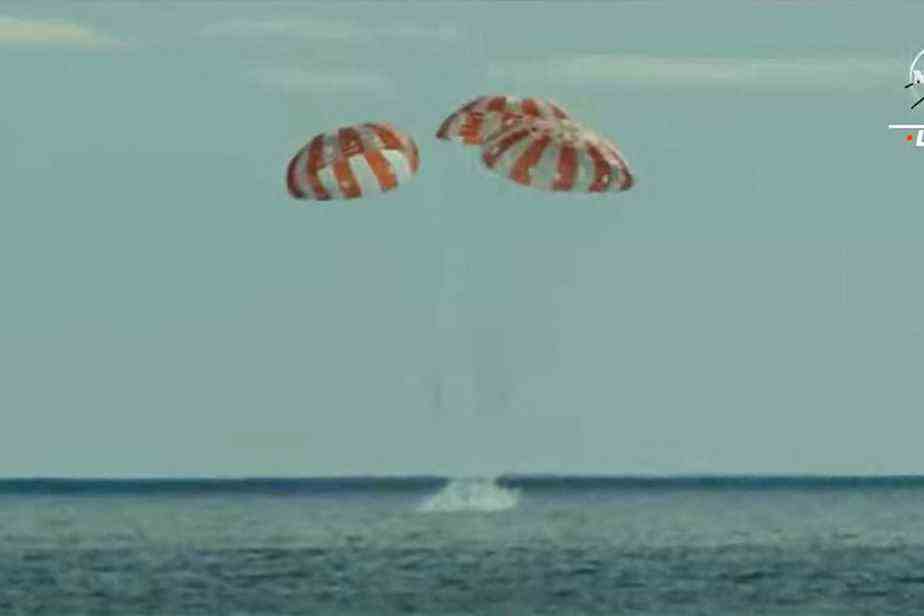The habitable capsule of the Artemis 1 mission successfully landed on Sunday afternoon near the coast of Mexican Baja California. This is the last major test before the first human lunar mission since 1972.
“The big test of Artemis is the return to Earth”, explained this week in an interview with astronaut David Saint-Jacques. “It is essential to verify that the heat shield that absorbs the heat of the re-entry into the Earth’s atmosphere will function as intended. There is no way to verify this on Earth. »
When a capsule returns from the International Space Station, it encounters the Earth’s atmosphere at 8 km/s. But Orion, the Artemis capsule, arrives at 12 km/s. It must therefore be slowed down by a first contact with the atmosphere, a bit like a pebble that is bounced once on water. The same tactic was used for Apollo and for lunar robotic missions, but with a lower bounce, with only a partial exit from the Earth’s atmosphere. The full rebound ofOrion also allows you to land closer to the Californian coast.
If all goes well, Artemis 2 should take place at the end of 2024 – NASA needs two years to prepare for this mission, which will include an orbit around the Moon. Artemis 2 will include a Canadian astronaut, who will likely be chosen by the summer, according to Isabelle Tremblay, director of astronauts at the CSA. Besides Mr. Saint-Jacques, the other astronauts who could be chosen for Artemis 2 are Jeremy Hansen, Jenni Sidey-Gibbons and Joshua Kutryk. Artemis 3 is scheduled to take place in 2025 and includes a moon landing.
Fuel
In other good news, Artemis 1 used slightly less fuel than expected, according to Mme Tremblay. Just over 3.6 tons of fuel had been brought to the Moon, with a safety margin of one ton. The mission burned about 80 kg less than expected.
Saint-Jacques, who is in Houston working on Space Station astronaut sorties and Canadian robotic arm operations, had several informal discussions with Artemis 1 controllers. adjustments, especially in communication and navigation systems. Each piece has been tested, but never all together in the operational environment. »
Artemis 1 was “piloted” by mannequins which are covered with radiation sensors. “It’s the big unknown. On Earth, the magnetic field protects us from space radiation, says Saint-Jacques. The International Space Station is in low enough orbit to be pretty well protected too. With the data from Artemis 1, adjustments can be made to astronaut protective gear and equipment. »
How were the Apollo astronauts protected from radiation? “At the time, the problem was not widely known, so we took a little luck,” says Saint-Jacques. It went well, but since then we have made a lot of technological progress so we have to make sure that everything will be fine. »
The system that will supply oxygen to the astronauts’ cabin and remove CO2 they exhale has not been tested on Artemis 1, but that does not worry Mr. Saint-Jacques unduly. “We have a lot of experience in this area. And we used the system to circulate nitrogen. If it works with nitrogen, it will work with oxygen. »
Generation Artemis
David Saint-Jacques is thrilled with the images of Artemis 1. The cameras are much better than those of Apollo. It’s really trippy. I think the young people will come on board. It’s going to be the Artemis generation. »
Two Canadian Missions
As Artemis 1 returned to Earth, two Ontario technologies made their way to the Moon aboard Japanese company Ispace’s private Hakuto mission. Hakuto, which includes a lander and a rover, will use Canadensys’ imaging system and Mission Control’s geological analysis computer. A Sherbrooke firm, NGC Aérospatiale, will analyze the imagery of these two Ontario technologies to refine its positioning and guidance system, which could be used for a lunar equivalent of the terrestrial GPS system.
Learn more
-
- 260 billion US
- Apollo program cost in 2020 dollars
SOURCE: NASA
- 93 billionUS
- Estimated cost of the Artemis program until 2025
SOURCE: NASA
-
- 2800 degrees Celsius
- maximum temperature of Orion during its re-entry into the atmosphere
SOURCE: NASA
- 5500 degrees Celsius
- surface temperature of the Sun
SOURCE: NASA
